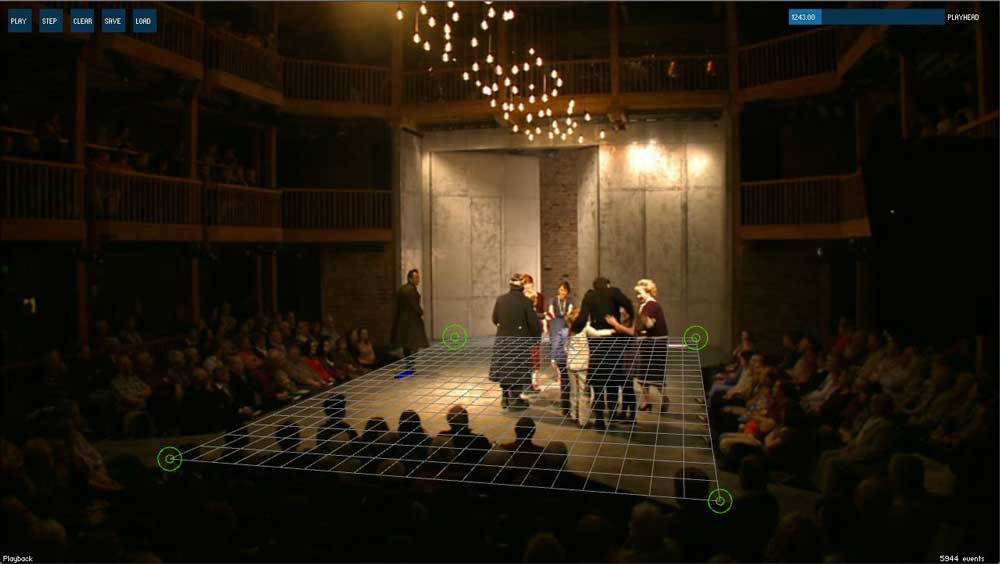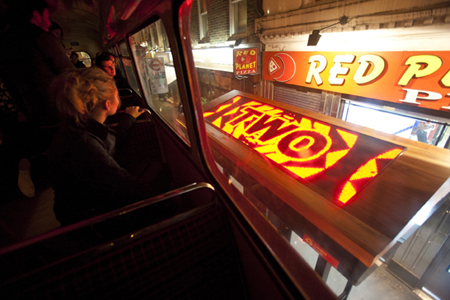-
Simple, but non-horrible Processing GUI library that isn't ControlP5.
New Work: Spirits Melted Into Air
22 November 2012
I’m excited to be able to share Spirits Melted Into Air with you: a two-week exploration I produced with the Royal Shakespeare Company, as part of their myShakespeare project.
The work is in parts a technology prototype, data visualisation, and artwork. Custom-built, open-source software is used to analyse performance video and generate plots of actors’ positions on stage from a perspective viewpoint. These plots are then used to generate new, secondary artworks: posters, and laser-cut wooden shapes.

The project emerged from an initial workshop and commission by Caper, where we explored various potential ways for technologists to collaborate with the RSC on short projects. From there, I dealt with the RSC direct, meeting key members of their team and understanding a bit more about the various factors influencing performances and productions there.
It was great to be able to take such a fluid, interpretative approach to the work. With hindsight, this was unsurprising: the RSC’s business is interpretation – taking Shakespeare and producing entirely new productions each year, of plays they have often performed countless times. My work was similarly interpretative: initially, building software to explore the data, and then exploring that data as a material – before moving onto the further material exploration of output formats. It’s the sort of structure to work that I’m fond of.

It was also great to have a brief to shape, and ultimately push myself: not just exploring a single technical idea, but seeing it through, end-to-end, to output and display. It was important to me that whatever came out of it – however prototype-y – was both beautiful and accessible. I think the output – especially the lasercuts – has stood up to that internal demand.
Thanks to Rachel and Kat at Caper for setting up the initial commission and the workshops; to Sarah and Ida, for producing the work from the RSC so superbly; and to everyone I met at the RSC who offered insight, ideas, and knowledge.
You can find out more at the Spirits Melted Into Air website.
And, if you’d like to know more about it, or indeed, to work with me on similar work – be it investigative, creative, or artistic – do get in touch.
-
MattB writes down his tips for language processing/machine learning; useful that somebody's done this.
-
"DAController is a wrapper class for use with the proCONTROLL joystick library written by Christian Riekoff for Processing. It encapsulates the two analog sticks and all the buttons found on a typical dual analog controller." Ooh.
-
"We'll know we're doing it right when half of the pages are ugly."
-
"The proCONTROLL library allows Processing to communicate with controll devices like joysticks, joypads but also keyboards and mice." It works quite nicely.
Raining on bus (s)tops
05 February 2012

or: “I made some public art”.
It’s been lovely to see Bus Tops finally emerge into the world. If you’re not aware: it’s a series of LED-matrix screens on the top of bus stops around London, displaying a curated programme of art that anyone can submit works to. It’s been beautiful to see it come to life so well: feels like a thing, has its own aesthetic, the public nature of it feels exciting and odd and transgressive.
I decided I ought to start making some things for it. I’m particularly interested in the screens as an animated medium. So far, I’ve submitted two works; one, an original, and the other, very much not, although it’s the kind of thing that needs to be on giant red LED matrixes.
Anyhow.
Ripples has been selected for display, which is quite exciting! It’s a short animation that makes it look a little like it’s raining on top of the bus stop, even when it’s not. It was a nice exercise for me: making something attractive, graphical, in code (which is not my sweet spot of programming).
An hour or so with Processing later and I was getting somewhere, and it didn’t take much longer with the rather lovely gifAnimation library to spit out an animated gif to import into the Bus Tops editor.
The original animation that Ripples is based on can be viewed here. The source code for it is also on that site.
This feels like a good beginning, and I have a few more ideas for abstract moving works that would look good in red, black, and nighttime, from the top of a double-decker.
(And, as reference primarily for myself: the way you fixed “sad about not making things” is by just starting things, ideally small things, and before you know they’re done.)
Update: and here’s what it looks like on top of a bus stop. Static:

and in motion:
-
"You can control time when you can see it." Things I like here: half-day resolution; tracking time as a group, rather than solo activity; the value of projects that may be numerically "over budget". Meetings as "0" is interesting; I'm not sure about that yet.
-
Nice tutorial for exploring AR with Processing. (Yes, I know it's AR, but I also am interested in how this works, so stop your booing in the peanut gallery).
-
"The film was shot back through the earth's atmosphere in buckets that parachuted over the Pacific Ocean, where C-130 Air Force planes snagged them with grappling hooks." You cannot make this stuff up. Hexagon sounds phenomenal.
-
"I’m excited to announce that I’ve been contracted by O’Reilly to write a book about the Microsoft Kinect. The book is tentatively titled Making Things See: Computer Vision with the Microsoft Kinect, Processing, and Arduino. My goal is to introduce users to working with the Kinect’s depth camera and skeleton tracking abilities in their own projects and also to put those abilities in the wider context of the fields of gestural interfaces, 3D scanning, computer animation, and robotics." Nice. Joining this stuff together is *hard*, and getting it into the hands of designers, rather than programmers, is very important.
-
"This is all very preliminary, but here is a first pass as a Processing Kinect library." Ooh.
-
Trap streets – yes, of course. But trap rooms; trap architectures? That's iiinteresting.
-
"Bookland is a fictitious country created in the 1980s in order to reserve a Unique Country Code (UCC) prefix for EAN identifiers of published books, regardless of country of origin, so that the EAN space can catalog books by ISBN rather than maintaining a redundant parallel numbering system." Awesome. Via Kim (who else?)
-
"This tutorial assumes no previous knowledge of scripting or programming, but progresses rapidly toward an intermediate/advanced level of instruction . . . all the while sneaking in little nuggets of UNIX® wisdom and lore. It serves as a textbook, a manual for self-study, and a reference and source of knowledge on shell scripting techniques. The exercises and heavily-commented examples invite active reader participation, under the premise that the only way to really learn scripting is to write scripts." Really good stuff, which Nick pointed me at this morning when I revealed I couldn't write bash scripts.
-
"Die Hard asks naive but powerful questions: If you have to get from A to B—that is, from the 31st floor to the lobby, or from the 26th floor to the roof—why not blast, carve, shoot, lockpick, and climb your way there, hitchhiking rides atop elevator cars and meandering through the labyrinthine, previously unexposed back-corridors of the built environment?" Marvellous, marvellous article, citing that Weizman piece I always end up citing, and looking how John McClane traverses the Nakatomi Plaza tower not through its corridors and elevators, but by literally infesting it.
-
"As computer technology has evolved to make artificial images look ever more real – so that the latest generation of shooter and war games will look as realistic as possible – ajpeg is intended to go the opposite way: Instead of creating an image artificially with the intent of making it look as photo-realistic as possible, it takes an image captured from life and transforms it into something that looks real and not real at the same time." Beautiful.